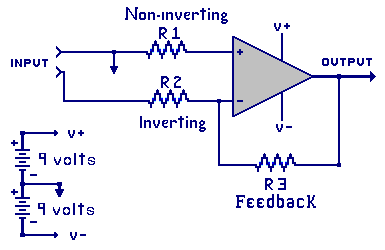This is Book 2
Chapter 7 - AC and Hertz
Chapter 8 - Magnetism
Chapter 8.2 - Inductors
Chapter 9 - Power Supply
Chapter 9.2 - Power Supply Filters
Chapter 10 - IC's and Amplifier
Chapter 10.2 - OP AMP Feedback and Unity Gain
Chapter 10.3 - OP AMP Non-Inverting
Chapter 10.4 - OP AMP Inverting
Chapter 11 - 555 Timer
Chapter 11.2 - Counters
Chapter 12 - Logic
Back To The Guide
Take Me Home
Op Amp - Dual Rail Supply
This configuration is a Inverting Operational Amplifier using a dual-rail
supply consists of two 9 volt batteries. The supply provides +9V (one rail),
with respect to the circuit common(ground) as well as -9V (another rail).
The resistors value for R1 and R2 are 10K and the value for R3 is 100K.
Notice that one input port, feeds into R2. The other end of R2 and R3 form
a voltage divider circuit around the inverting input pin, with R3 being the
feedback circuit. The IC's inverting voltage is a sum of the sources of R2
and R3. In the schematic drawing, the other input port is connected to the
circuit common.
The non-inverter pin is tied through R1 to circuit common. R1 keeps the
input from floating and picking up stray signals. In this amplifier the input
changes will all take place on the inverting input circuitry. OK, Here is how this works.
Positive input voltage:
1) The output is sitting at O volts due to the two input voltages being
at 0 volts. No voltage drop is across R1, R2 or R3. The Op Amp is at
State-2.
2) When a +0.1 V is applied to the inverting signal input terminal, current
will start to flow through R2, which will increase the inverting pin
voltage above the non-inverting pin. The Op Amp moves to state-1 and
the output voltage starts moving down toward the V- voltage. This
continues until R3 can pull the voltage applied through the voltage
divider to the inverting pin to the same potential as the non-inverting
pin.
3) Question: With the input port voltage at +0.1v and both IC inputs
back to 0.0V, what is the output voltage?
Using Ohms law and the basic R2, R3 voltage divider,
we can calculate the output voltage of the amplifier.
There is 0.1 volts across R2 of 10,000 ohms.
R2 current = 0.1/10000 or 0.01mA
There is the same 0.01mA through R3 of 100,000 Ohms.
R3 voltage = 0.00001 X 100000 or 1V.
Output voltage is - 1.0 volts.
SO: It takes 1.0V output in the negative direction to
offset the 0.1V input to keep the inverting pin at 0.0V
4) The voltage gain of this amplifier.
The GAIN equals R3/R2 or 100K/10K or a GAIN of 10
Negative input voltage
5) Now by decreasing the input port voltage to -0.1V, the
inverter pin will signal the op amp to jump to State-3. The
output starts increasing. The R3 starts applying that feedback
voltage to the inverting pin until that pin returns back to
0.0 volts at which point the op amp switched back to stage-2.
6) Find the new output voltage the same way.
There is still a voltage drop across R2 of 0.1 V,
just in the other direction this time, so -0.1V.
The divider current is the same as 0.01 mA in the circuit.
Output voltage is +1.0V
The gain is the same at 10
There are a number of different operational amplifiers on the market today.
Some models like the CA3033, are no longer available and new IC's show up on
the market from time to time. One of the most common over the years is the 741.
There are additional letters and numbers as part of the actual part number to
designate manufacturers, temperature ranges and alike. Op Amps come in many
different pin configurations and specifications.
Here is a short list of some common IC's.
Id = general part identification
Slew = slew rate is output voltage change per microsecond.
Volts = power supply voltage range
Tmp = operating temperature limits in degrees C
Cost = general cost range (reference not actual cost)
ID for Single op amp in a package
3140 - 9.0V-Slew, 4Volts to 36Volts -55 to 125 C 2.50 dollars
201 -- 0.5V-Slew, 5Volts to 22Volts -25 to 85 C 0.50 dollars
2904 - 0.1V-Slew, 3Volts to 26Volts -40 to 125 C 1.50 dollars
747 -- 0.5V-Slew, 10Volts to 36Volts 0 to 70 C 0.50 dollars
OP07 - 0.3V-Slew, 3Volts to 18Volts 0 to 70 C 0.50 dollars
ID for Dual and Quad Op Amps
158 - 0.6V-Slew, 3Volts to 30 Volts -55 to 125 C 2.50 dollars
258 - 0.6V-Slew, 3Volts to 30 Volts -25 to 85 C 0.50 dollars
358 - 0.6V-Slew, 3Volts to 30 Volts 0 to 70 C 0.50 dollars
324 - 0.5V-Slew, 4Volts to 32 Volts 0 to 70 C 0.50 dollars
You can see from these sample charts that if you want an IC that is very
fast, and can work outside both summer and winter the 3140 is the fastest
one here with a wide temperature range, and a higher reference cost.
« Previous Chapter Next Chapter »
Email us: info@shoeboxkits.com

